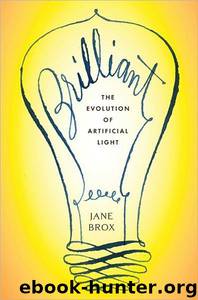Brilliant: The Evolution of Artificial Light by Jane Brox

Author:Jane Brox
Language: eng
Format: mobi, epub
Tags: Non-fiction, Science, History
ISBN: 9780547055275
Publisher: Houghton Mifflin Harcourt
Published: 2010-07-08T00:00:00+00:00
12. Alone in the Dark
They are pronounced overhauls ... the swift, simple, and inevitably supine gestures of dressing and of undressing, which, as is less true of any other garment, are those of harnessing and of unharnessing the shoulders of a tired and hard-used animal.
They are round as stovepipes in the legs, (though some wives, told to, crease them).
In the strapping across the kidneys they again resemble work harness, and in their crossed straps and tin buttons.
—JAMES AGEE,
Let Us Now Praise Famous Men
WITH THEIR LACK of electricity, people living in densely packed poor city neighborhoods could claim close kinship to rural Americans, who, in the first three decades of the twentieth century, also had little expectation that electricity would soon come to them. Electrification of the countryside was an expensive, labor-intensive proposition. Rural lines had to be sturdier than urban ones to withstand the open miles, the winds, the ice and sleet. They could be difficult to string because the lay of the land and the kinds of soil—clay, sandy, stony—varied widely along the routes. Trees had to be trimmed away from the lines. And, since rural lines guaranteed at most only one, two, or three customers per mile—and cautious, parsimonious farmers at that—in contrast to the dozens of customers per mile in cities, electric companies reasoned that rural electrification wouldn't be worth pursuing until all other markets had been fully developed and exploited. If then.
It's not that electricity on the farm hadn't been imagined. During the last decades of the nineteenth century, in Europe especially, scientists had experimented with electric plows, harrows, threshers, pumps, and milking machines. They had constructed electric fences, smudge pots, sheep shears, and prods for balky horses. Electricity, they imagined, would keep down frost, fertilize the soil, milk cows, and destroy weeds. Electric lights would extend harvest days, increase germination, incubate eggs, encourage hens to lay in winter, and keep chicks warm in spring. Electrified rain would spur growth. A farmer one day, it was said, "will be a highly skilled electrician, who from a central switchboard at his farm will direct the germination and growth of cabbages, carrots, potatoes and other crops." And an electrified rural world must have seemed all the more probable after Tesla's motors and transformers created the first long-distance power lines between Niagara and Buffalo. As early as 1895, an article in the Country Gentleman predicted that "not improbably the barefoot boy now driving home the cows, when arrived at man's estate, [will] be gaily turning the sod on a Montgomery County farm by a three-share electric plow, with all the power of Niagara Falls behind him."
Yet to turn to the American countryside in 1920 was to part ways with progress. At the time, there were about 6.5 million farms in the United States. Fewer than 100,000 of them were connected to central stations, and most of those were located in small northeastern states near cities, or on the West Coast, where irrigation spurred the development of electric lines. And farmers who were connected to high lines could pay twice as much as city dwellers for service.
Download
Brilliant: The Evolution of Artificial Light by Jane Brox.epub
This site does not store any files on its server. We only index and link to content provided by other sites. Please contact the content providers to delete copyright contents if any and email us, we'll remove relevant links or contents immediately.
| Anatomy | Animals |
| Bacteriology | Biochemistry |
| Bioelectricity | Bioinformatics |
| Biology | Biophysics |
| Biotechnology | Botany |
| Ecology | Genetics |
| Paleontology | Plants |
| Taxonomic Classification | Zoology |
Sapiens: A Brief History of Humankind by Yuval Noah Harari(14248)
The Tidewater Tales by John Barth(12608)
Mastermind: How to Think Like Sherlock Holmes by Maria Konnikova(7224)
Do No Harm Stories of Life, Death and Brain Surgery by Henry Marsh(6887)
The Thirst by Nesbo Jo(6826)
Why We Sleep: Unlocking the Power of Sleep and Dreams by Matthew Walker(6618)
Life 3.0: Being Human in the Age of Artificial Intelligence by Tegmark Max(5474)
Sapiens by Yuval Noah Harari(5293)
The Longevity Diet by Valter Longo(5017)
The Body: A Guide for Occupants by Bill Bryson(4974)
The Rules Do Not Apply by Ariel Levy(4850)
The Immortal Life of Henrietta Lacks by Rebecca Skloot(4525)
Animal Frequency by Melissa Alvarez(4394)
Why We Sleep by Matthew Walker(4359)
The Hacking of the American Mind by Robert H. Lustig(4318)
Yoga Anatomy by Kaminoff Leslie(4303)
All Creatures Great and Small by James Herriot(4231)
Double Down (Diary of a Wimpy Kid Book 11) by Jeff Kinney(4206)
Barron's AP Biology by Goldberg M.S. Deborah T(4096)
